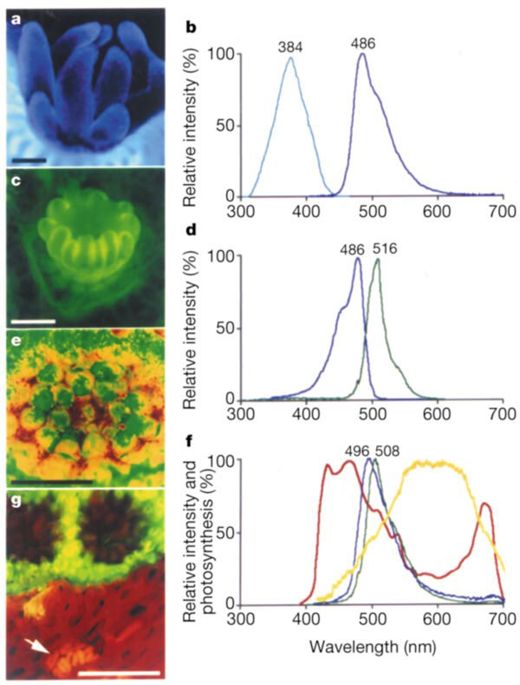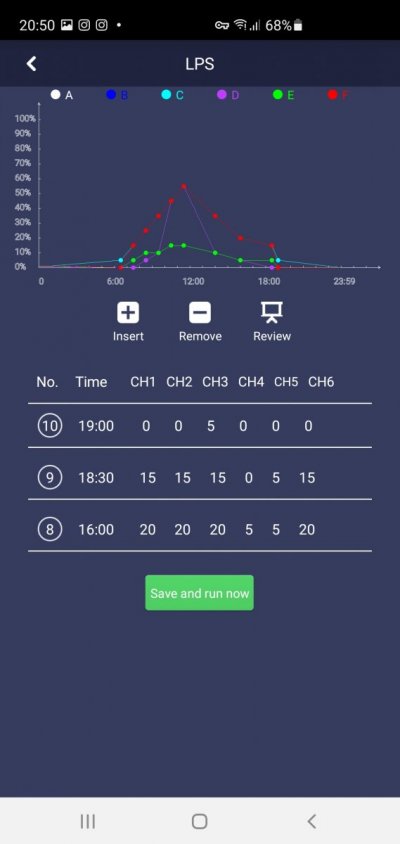Navigation
Install the app
How to install the app on iOS
Follow along with the video below to see how to install our site as a web app on your home screen.
Note: This feature may not be available in some browsers.
More options
You are using an out of date browser. It may not display this or other websites correctly.
You should upgrade or use an alternative browser.
You should upgrade or use an alternative browser.
What, blue versus white, lighting combo gives the best coral growth?
- QUESTION OF THE DAY
- Thread starter revhtree
- Start date
- Tagged users None
- Joined
- May 13, 2017
- Messages
- 2,453
- Reaction score
- 1,280
The aquablue special has almost all the blue that the blue plus does, only adds some whites too. 65k are good to but I found they are best when mixed with blue plus to get the added blue peaks.6500k freshwater T5 bulbs are overlooked as well.
The response to light spectrum is species specific and likely varies at the genotype level as well and I wouldn't be surprised if differetn clades of zoozanthellea also influences growth. Like everything else in life it doesn't matter what you do somebody won't like what you did.
On my Red Sea 90, I run 40% blue and 50% white and I’m seeing really good coral growth.
Mine is balanced between the 2.

This is the preset schedule on the app for my Aquanest Lights for SPS, and LPS from the manufacturer. I have yet to turn on my lights on my new tank. I have yet to decide what to do. I am intending to get an Apogee Par meter, and measure my existing tank, where I got lucky on the settings


Attachments
What are the radium’s color? 20k?Fwiw here is old school halide lighting on a mixed 210. Radium 250w x3 and 2 diy led bars consisting of 18 hyper violets and 18 royal blue 3w diodes. Very neutral white with a hint of blue in person with decent coral color pop. No photo editing or filters Gives the fish and corals a natural look but still some color pop
There is no dedicated mix of blue vs white not to mention if u run mostly blue with no red your corals will grow but it also makes them a friendly home to diseases as red in any photosynthetic life helps with the immune system and the balance of blue and white depends on what your growing don't blast low light coral with intense blues u will kill it and don't try and grow acros under t8 white lights as it will not grow
Personally I like 50 percent white 30 percent blue 10 percent red and then the rest is orange green and purple not ultraviolet but purple right before u hit uv
I honestly don't think their is a ratio of blue and white lighting when it comes to the growth, and more importantly, the health of the corals. Each tank is different, and thus, the percentage of lighting will be different.
Do we really know that? I´m not so sure on that - what I´m sure of is that it often see this claim here on R2R - but have not seen any investigations that really show it.Today we know differently but what exactly is the BEST percentage combo to experience the best coral growth from a lighting aspect?
Corals really don't use much of the yellow and green in the middle of the spectrum.
According to green - Its true in one aspect - there is not as effective uptake of green photons as it is compared with some red and some blue if you see it in a two dimensional aspect. But if you see it in a 3 dimensional aspect the result can be different.
Look at this photos. They show the top side and the underside of a leaf from a pot plant illuminated from the top side by an LED flashlight with white LED (phosphorous coated). The top side get hit of all type of photons between 400 and 700 nm (photo 1) - the underside is only green (Photo 2) it means only green photons pass through. it should have been white if all photons had pass through in the same amount they leave the flashlight. If I use a light on the top side - the backside is total black - no photons leaving the tissue. If I use a red LED - the backside is red - but rather weak - not all red photons will be assimilated - some penetrate.
The low use of green photons and the ability of green photons to penetrate living tissue is the reason why you still can have photosynthesis in trees and plants below a nearly 100% canopy cover.
This is a long post - I will come back later with the importance to use RGB leds later
Sincerely Lasse
Last edited:
I think people over think this. The actinic range is complicated. Are we talking Windex blue, royal blue, near UV? As long as you have some red, some blue and enough over all PAR, then the balance should be more about what looks good to you. Even within the actinic/UV range, there are stark differences in what colors are brought out in corals, but they are all beneficial for photosynthesis. I say just invest in a descent par sensor, find a balance that that looks good to you and allows you to enjoy the fruits of your labor while providing adequate PAR for healthy growth.
Last edited:
Not as simple as Blue vs. White. White light is made up of all the color spectrums that include the blue spectrum. Generally speaking, the most beneficial light for corals and their zooxanthella is light in the violet to blue green portion of the spectrum (that includes blue) and a little in the red orange to red spectrum. These colors are at each end of the visible light spectrum. Corals really don't use much of the yellow and green in the middle of the spectrum. Unfortunately, there is normally a lot of those in standard white lighting. It may be that the benefit of using white light is just to replace the red spectrum that is missing from blue lights.
Red doesn't seem to be something corals prefer plus it barely penetrates water and those who receive red light are likely closed up and in photoinhibition during those hours of the day to protect themselves (I imagine red is barely scratching the surface during non peak hours of the day).
Take a minute and figure out what this chart really says according the penetration of different wavelength. the black circle will make the windex look. You can´t role out red just because pf penetration - when you need to tole out the windex wavelengths too. An in nature - its a lot of corals 10 m and up

Sincerely Lasse
I think a better question is what color light is best for the fish's behavior. It seems the blue is set and people vary the white by their preference. I used to run only blue, but then was concerned that I was providing an environment that is extremely abnormal for the fish, and that I bet that there are interactions between the light color and the behavior of the fish given that they have the capability to see a wide range of colors.
Take a minute and figure out what this chart really says according the penetration of different wavelength. the black circle will make the windex look. You can´t role out red just because pf penetration - when you need to tole out the windex wavelengths too. An in nature - its a lot of corals 10 m and up
Sincerely Lasse
I never really said anything about UV-A but I do know what you mean by many hobbyists thinking UV might be helpful. I don't think UV-A is important in photosynthesis as most photopigments that I know of are not very excited below 380nm. A lot of corals that are in very shallow waters are protecting themselves from extreme par numbers during the day and are often much smaller than those further out. The area where red is present leads to many corals only being able to photosynthesize at dawn and dusk. Chlorophyll a and c2, for example, support the idea the algae is very much utilizing the light that penetrates the deepest other than the some green but that may be due to solving physics issue with energy variation (sci show did a great episode on that). The reason why red may be utilized by chlorophyll but not the algae in corals may be a retained ancestral trait of zooxanthellae ancestors before they began their mutualistic relationship with corals.
Red Light Represses the Photophysiology of the Scleractinian Coral Stylophora pistillata
Light spectrum plays a key role in the biology of symbiotic corals, with blue light resulting in higher coral growth, zooxanthellae density, chlorophyll a content and photosynthesis rates as compared to red light. However, it is still unclear whether these physiological processes are...

Fluorescent pigments in corals are photoprotective - Nature
All reef-forming corals depend on the photosynthesis performed by their algal symbiont, and such corals are therefore restricted to the photic zone. The intensity of light in this zone declines over several orders of magnitude—from high and damaging levels at the surface to extreme shade...
The Wijgerde article is interesting but IMO it is possible to interpret the result quite the opposite. The zooxanthellae density as one example. It is possible to say that the red wavelengths is so effective that the job can be done with fewer zooxanthellae. The zink concentration could also been a factor in the experiment.
Sincerely Lasse
Sincerely Lasse
I have my white start at 10% for a few hours in my light cycle and then have it drop to 0% over the course of 2 hours.
- Joined
- Mar 11, 2019
- Messages
- 173
- Reaction score
- 236
I run a hybrid. I have tried many different color combo’s for the bulbs. I find my favorite is all ATI blue plus and my kessils at 60% intensity and 50% white at the peak.
It is aesthetically pleasing and the corals seem to really like it. All the frags are showing good growth and color.

It is aesthetically pleasing and the corals seem to really like it. All the frags are showing good growth and color.
Similar threads
-
- Poll
- Replies
- 54
- Views
- 2,822
- Replies
- 62
- Views
- 573
- Replies
- 10
- Views
- 427
- Replies
- 9
- Views
- 227



















